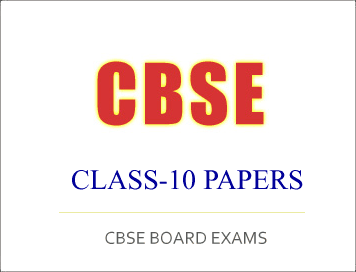CBSE Class-10 Exam 2016 : Delhi Scheme Question Paper, Social Science
Disclaimer: This website is NOT associated with CBSE, for official website of CBSE visit - www.cbse.gov.in
CBSE Class-10 Exam 2016 : Delhi Scheme
Question Paper, Social Science
CBSE Class-10 Exam 2016 : Social Science
SOCIAL SCIENCE
Time allowed : 3 hours ]
[ Maximum marks : 90
General Instructions :
(i) The question paper has 30 questions in all. All questions are compulsory.
(ii) Marks are indicated against each question.
(iii) Questions from serial number 1 to 8 are very short answer questions. Each question carries 1 mark.
(iv) Questions from serial number 9 to 20 are 3 marks questions. Answer of these questions should not exceed 80 words each.
(v) Questions from serial number 21 to 28 are 5 marks questions. Answer of these questions should not exceed 100 words each.
(vi) Question number 29 and 30 are map questions of 3 marks each from History and Geography both. After completion, attach the maps inside your answer-book.
1. Name the Treaty of 1832 that recognised Greece as an independent nation.
Or
What was the result of the peace negotiation in Geneva that followed the French defeat in Vietnam?
2. Why are there a wide range of colours, hardness, crystal forms, lustre and density found in minerals?
3. How are issue specific movements different from generic movements?
4. Name any one political party that has national level political organisation but not recognised as the national political party.
5. Which organisation led the protest against water privatisation in Bolivia?
6. Differentiate between investment and foreign investment.
7. Suppose you have to buy a packed bottle for drinking water in your journey. Which logo will you like to see to be sure about its quality?
8. How do the deposits with banks become their source of income?
9. How had the female figures become an allegory of the nation during nineteenth century in Europe? Analyse.
Or
How did nationalism emerge in Vietnam through the efforts of different sections of society to fight against the French? Analyse.
10.Who had designed the ‘swaraj flag’ by 1921? Explain the main features of this ‘swaraj flag.’
11.“The Civil Disobedience Movement was different from the Non- Cooperation Movement.” Support the statement with examples.
12. Classify industries on the basis of capital investment. How are they different from one another? Explain with examples.
13. “Efficient means of transport are pre-requisites for the fast development.” Express your views in favour of this statement.

